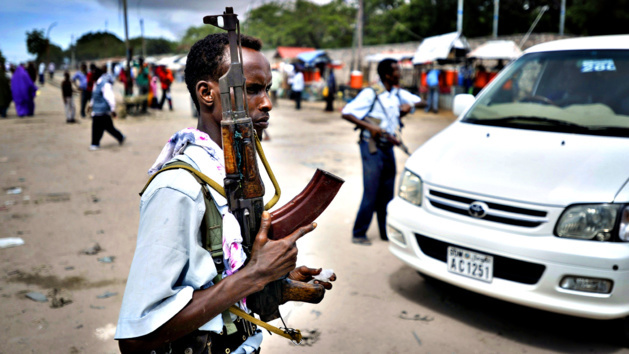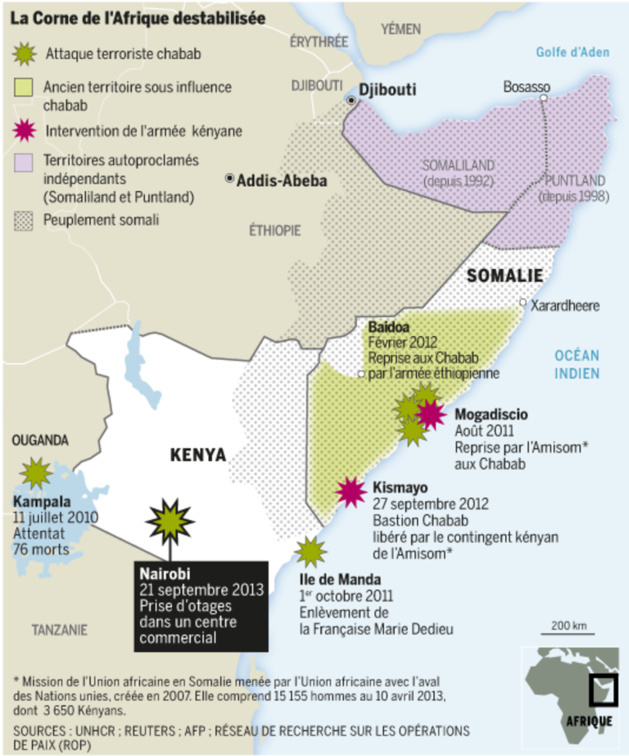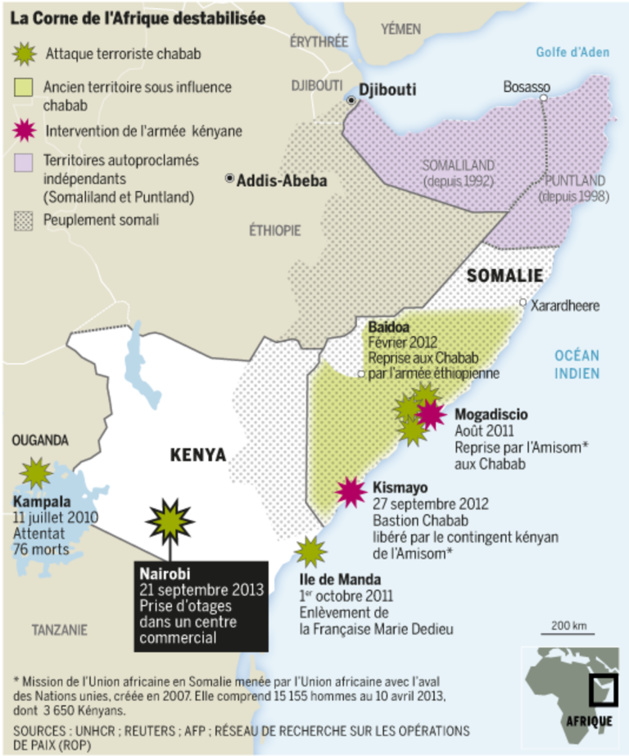
Crédit Tobin Jones, AFP
Mogadishu, Saturday 10 January, 2 p.m. The Ministers of Foreign Affairs from Kenya, Ethiopia, Southern Sudan and Djibouti sat around a table, discussing the how to solve the Somali conflict. This meeting was described as the first of its kind in 30 years and the acting Somali Minister of Foreign Affairs, Dr. Abdirahman Beyle, welcomed the fact that Mogadishu was safe enough to host such a conference. Except that outside, safety required a battalion of security forces to be on patrol, the city to be put in lockdown and the businesses to close.
Indeed, even if al-Shabaab has endured important military defeats and, amongst other things, the loss of key figures of the movement, its operational capacities have not been weakened. When the leader Ahmed Abdi Godane died following an air strike conducted on September 6, 2014, his supporters responded 2 days later with a suicide attack in the North of the capital.
Radicalization and intervention
The declared goal of al-Shabaab (“youth” in Arabic) is to create an Islamic State in Somalia. Considered a terrorist organization by the United States, Australia, the United Kingdom, Canada, Norway, New Zealand and France, its members are estimated to be a few thousands. They come from a radical militia from the Islamic Courts Union (ICU), an organization that gained weight and power at the beginning of the 2000s. The ICU is an alliance of Islamic courts applying the sharia, implemented in order to meet the needs of justice, and to compensate for the absence of the State in this sector.
According to some observers, the ICU brought a semblance of peace after 15 years of civil war, but it still was a form of non-state power that could not be manipulated and was therefore all the more threatening through its opacity. Yet, the opposition to the American-Ethiopian invasion, who sense a clear threat of terrorism amongst the members of the ICU, is going to radicalize some of them. It is partly the small group of al-Shabaab that is going to recover the gains from this radicalization.
For Roland Marchal, al-Shabaab emerged during this military intervention, reminding us of the destructive inefficiency of fighting fire with fire. It also reminded us of the lack of understanding between two models of governments, between different cultures, that the operators’ strategies have to face. While it is easy to blame the American people, it is also important not to isolate them. In Somalia, this military choice that bogged them down in a never-ending war against terrorism was a choice made by several actors.
For Ethiopia, Al Qaeda has a hold on the ICU through this Islamist group. And even if al-Shabaab made up just a small group, largely in minority, the assumed premise is that military intervention has to enable the full eradication of the ICU. So, the Ethiopians, who share interests with the Americans, have received support since 2001 that increased seventeen fold between 2001 and 2004, as well as trainings from American counselors and important air assets for their professional army. In Spring 2007, the ICU fell, partly due to the power of the American-Ethiopian invasion, and partly due to internal divisions.
The Shabaab, who got stronger from the defeat, radicalized all the more so as they mobilized people, despite strategy mistakes. Their popularity varied from one region to another. The fact remained that they controlled a big part of the Somali territory and they protested against the government’s authority. At first glance, their application of the sharia came under a Salafist and rigorist vision of Islam.
The Unitarian and nodal myth
Linda Nchi is the military operation launched by Kenya since October 2011 in Somalia, after a long period when the country did not express its opinion on Somali civil war. The particularly deadly attack organized in Nairobi in September 2013 is then seen as a punitive strike from al-Shabaab,directly targeted by the Kenyan intervention. Yet, beyond the deadly violence of the attack, it is important to note the divisions among the al-Shabaab leaders about the response they wanted to give after this intervention. The balance (the leader) leant in favor of the partisans for a punitive response, but others would have advised to abstain, as Nairobi remained a logistical support base useful to the movement.
The use of violence still generates debates, and it would be foolish to believe that a perverse unanimity chooses the use of a terrorist attack as their first choice. This complexity is visible in the modes of governance in the areas that al-Shabaab control. Differences exist about the application of the sharia (the Islamic law) and in the people’s behaviors. Despite a mediatized image that presents them as murderers, they are not only a terrorist group. They are also groups that govern, raise taxes and redistribute part of the riches.
“We cannot say that al-Shabaab is stronger than ever, but the movement has just lost its leader. On the other hand, it is completely illusory to think that al-Shabaab is an organization that is going to fall apart by tomorrow. What we can also see is that every time key figures of the movement have been killed, there has been a response, that is a significant terrorist attack.” (Roland Marchal, research project manager at CNRS and specialist in armed conflicts in Sub-Saharan Africa 2014)
Yet, the way interventionist policies are led is often covered up by nodal and unitarian concepts. We call them nodal, because people mistakenly think that a group has a core, a heart and a periphery that follows the heart. That if you kill the heart, you kill the body. It is the goal stated by air strikes. Last December, the American Ministry of Defense declared that the target of the strike was a high representative of al-Shabaab. The strike reached its target, killing the new representative of the Islamic group’s intelligence services. Godane’s death was perceived as a crucial victory. This strategy seems foolish considering the number of opponents, who are yet saddled with a ridiculous uniformity.
This cohesion, which exists in various scales, thrives on military fire. The victims tend to gather together, but not necessarily to the most radical parties of the opposition. But if these parties manage to get a positive impact on insecurity that its fellow citizens have to live with every day, their popularity is very likely to rise. Thus, al-Shabaab have known popular resistance. And yet, because of the invasion, the injustice that resulted from it and the daily measures like tax hikes, a substantial part of the population is going to side with them.
Al Qaeda’s concept “managed to transform a small organization into a power that now controls 80% of the territory in Central and Southern Somalia, and even more in terms of population”. (Roland Marchal, 2007). These concepts are also unitarian, because we think that the terrorist networks are linked together, like a giant web. al-Shabaab are themselves divided over the concept of fighting in the name of Islam. Several rival factions disunite the group. Aside from everyone’s personal ambition, we notice a division between partisans of a global Islamic revolution and those who are focused on a nationalist objective. In June 2013, two historical leaders, Ibrahim Haji Jama Mee'aad and Abdul Hamid Hashi Olhayi were killed by members of the group. The link with Al Qaeda is also questionable. Osama Bin Laden refused for a long time to bring together his organization with al-Shabaab, judging them too extremist in their methods.
It is only in 2012 that the new Al Qaeda leader, Ayman al-Zawahiri, accepted al-Shabaab’s request. Yet, today, this allegiance is again under question. Some members of the movement would now give priority to the union with the Islamic State. There are therefore a number of emotional, ambitious, but also thoughtful and strategic people that constitute this group. A proof that individualism takes precedence over the logic of a uniform group can be found in the surrender of the al-Shabaab intelligence leader, Zakariya Ismail Ahmed Hersi, last December. Al-Shabaab minimized this act, but only because self-expression, which was openly declared as dissident, threatens the image of a strong and unified group that al-Shabaab want to show.

Crédit infographie Le Monde
Imported legitimacy
In 2006, Somalia therefore became officially a place of war against international terrorism. The legitimacy of the action is imported, guided by a logic based on international events. The convergence of interests with the locals can only be seen with the elite. A gap exists between what the local governments consider legitimate and what the local populations perceive. Not to mention corruption that embezzles a third of the state budget that comes from international support. While the population clearly does not support the Transitional Federal Government (TFG), international donors do.
The elusive terrorist threat
The interventionist dynamic is strongly marked by a predominance of the choice of militarization. Terrorism, through its violence that seems to be able to strike “randomly”, easily pushes its victims to their limits. At the individual level, terrorism causes emotion. At our States level, terrorism is a threat like any other threat and has to be handled and “forecast”. Yet, terrorism did not remain just a statistical probability that needs a rational solution. Through its elusive and unpredictable nature, terrorism justifies the safety injections with which we drug our policies.
The fair war
So, today, the logic of self-defense takes precedence over the police logic and the use of justice. The concept of asymmetric war responds to this justification. It was theorized a long time before September 11 and it can be defined as a war between a rule of law and an illegitimate or inhuman enemy. No legitimacy is granted to its action or claims because violence destroys the act’s credibility and we do not negotiate with terrorists. Besides, if we go back in time, on December 6, 2006, the United States authorized the African Union to intervene in Somalia, through Resolution 1725, even though the negotiations were supposed to be taken up 10 days later.
The myth of safety at all costs
After September 11 and with the “war on terror”, the logic of the worst case scenario progressively spread through the strategic decisions with regard to the fight against terrorism. A “right to safety” was born and is now waved as the flag of the “free world”. The common acceptance “the safer, the happier” is wrong. Freedom, which we prefer to sacrifice on the altar of collective safety, is scary. Through the discursive power that we all spread, we manipulate our own fears, convinced that what applies to us does not apply to others, as if the other people were not really human after all, as if they did not respond to the same social complexity.
Opinion, for everybody, plays a role in the choice of defense strategies, especially concerning the fight against terrorism. The demand for quick decision-making is very likely to lead to short-term measures that are most of the time also motivated by the imminence of elections. Demagogy takes over and the game of democratic institutions ends here: we elect people that we want to be more thoughtful than us to decide, but then we wish they would react like we would react in their place.
In societies where religious activism is perceived as a “heresy” by the foreign powers’ established secularism, some fringes of the population do not take into consideration other means of expression than resorting to violence, and make this choice at the expense of other alternatives. In the same way, militarizing the fight is a choice as there are other ways. The action can be of a terrorist nature but the group is not. Associating the action with its protagonist, and thus making them dependent on a catch-all Islamism, we avoid facing the fact that a terrorist act can be accomplished in a chosen and free way, for a number of possible reasons. Even if terror is a tragic strategy mistake, reason would dictate not to commit the even more obvious mistake to fight fire with fire.





























